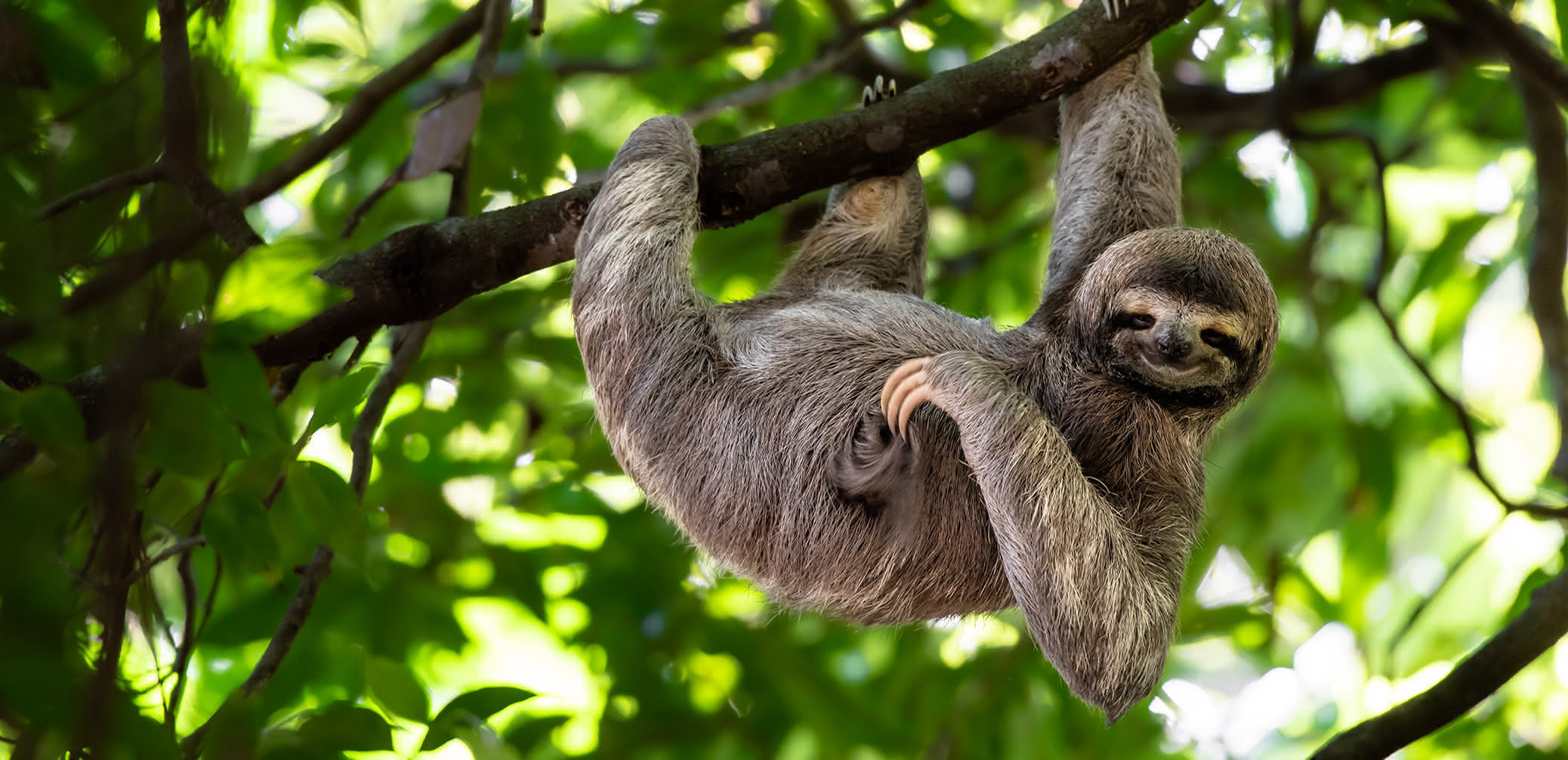What animals live in Costa Rica? The 10 best animals in Costa Rica are the Three-toed Sloth, Jaguar, Resplendent Quetzal, Harpy Eagle, Leatherback Sea Turtle, Golden Toad, Ocelot, Spider Monkey, Scarlet Macaw, Great Green Macaw and Toucan.
Spider monkeys are one of the most common animals you’ll see throughout Costa Rica, including on your hotel balcony and swinging past you in trees in the hotel grounds. These highly social animals are named after their appearance because they have spider-like long limbs and a long tail, making them very limber as they swing through the rainforest.
Conservation efforts in Costa Rica often involve a combination of habitat preservation, anti-poaching initiatives, and public awareness campaigns. Costa Rica has been proactive in implementing policies and initiatives to safeguard its unique and diverse wildlife.
Costa Rica is home to a rich diversity of wildlife, and many of its animals are protected to ensure their conservation. Here are ten examples of well-protected animals in Costa Rica:
1. Three-toed Sloth
Both the brown-throated and pale-throated three-toed sloths (Bradypus spp.) are found in Costa Rica. Their slow movements and unique lifestyle make them a symbol of the country’s rich biodiversity. We are such fans of these animals and have seen one in a tree slowly munching and watching us. It was worth traveling to Costa Rica for this experience alone.
We reviewed Four Seasons Costa Rica which is one of the best Four Seasons hotels in the world, and we reviewed Andaz Costa Rica during our trip to Costa Rica. Our luxury travel concierge offers free benefits at both of these hotels, along with all other luxury hotels around the world.
The three-toed sloth is a unique and fascinating arboreal mammal known for its slow movements and distinctive appearance. There are four extant species of three-toed sloths, and they are all native to Central and South America, including Costa Rica.
The three-toed sloth has a compact and rounded body covered in shaggy, coarse fur that can be grayish-brown to tan in color. Despite its name, the three-toed sloth has three claws on its forelimbs but actually has two toes on each hind limb. This distinguishes it from the two-toed sloth, which has two claws on its forelimbs.
Three-toed sloths are relatively small compared to other sloth species. They typically weigh between 8 to 10 pounds and have a body length of about 18 to 23 inches.
Three-toed sloths are adapted for an arboreal lifestyle. Their limbs are long and have specialized joints that allow for slow and deliberate movement. They are excellent climbers.
Sloths are renowned for their incredibly slow metabolism and deliberate movements, spending much of their time hanging upside down from tree branches. This is why you can sometimes spot them in the trees. They tend to hang there and are unlikely to move on when they see you.
The diet of three-toed sloths mainly consists of leaves, buds, and tender shoots. They have a specialized stomach with multiple compartments that aid in the digestion of their fibrous and low-nutrient diet.
Three-toed sloths are primarily nocturnal, being more active during the night. They are also solitary animals, with each individual typically inhabiting a well-defined home range.
Sloths have a relatively slow reproductive rate. Female sloths give birth to a single offspring, and the mother carries the baby sloth on her belly for an extended period. The young sloth clings to the mother for several months before becoming more independent.
Jaguars, harpy eagles, and some large snakes are among the main predators of sloths. The sloth’s slow movements and camouflage help them avoid detection, but they can be vulnerable during rare moments of ground travel.
While three-toed sloths are not currently considered endangered, they face threats from habitat loss due to deforestation, road construction, and human encroachment. Conservation efforts are essential to protect their natural habitats.
The three-toed sloth’s unique adaptations, slow lifestyle, and charming appearance have made it a symbol of curiosity and wonder in the animal kingdom. Their conservation is crucial for maintaining the biodiversity of the tropical rainforests in Costa Rica and beyond that they inhabit.
2. Jaguar
Jaguars (Panthera onca) are the largest big cats in the Americas and are considered near-threatened. Costa Rica has taken steps to protect their habitats and reduce human-wildlife conflict to ensure their survival.
Jaguars hold cultural significance in the indigenous cultures of the Americas and in Costa Rica. They are often revered as symbols of strength, power, and spirituality.
Historically, jaguars were found from the southern United States through Mexico, Central America, and South America. However, their range has significantly diminished due to habitat loss and fragmentation.
They inhabit a variety of ecosystems, including the rainforests of Costa Rica, swamps, grasslands, and scrublands. They are particularly associated with dense tropical rainforests found in Costa Rica but can adapt to a range of environments.
Jaguars are known for their powerful build, distinctive coat pattern, and strong, stocky appearance. Jaguars have a robust and muscular body with a distinctive golden-yellow coat covered in irregular black rosettes and spots. The coat pattern provides effective camouflage in their natural habitat.
Jaguars are the third-largest big cat species in the world, after tigers and lions. Adult males typically weigh between 150 to 250 pounds, while females are generally smaller.
Jaguars are solitary animals and are known for their elusive and secretive nature. They are primarily nocturnal hunters, preferring to hunt during the night, so you are unlikely to see one if you visit Costa Rica.
Jaguars are carnivorous predators with a diverse diet. Their prey includes a wide range of animals, such as deer, capybaras, peccaries, monkeys, and various types of birds. They are excellent swimmers and are known to hunt aquatic prey, such as fish and caimans. Jaguars are known for their powerful bite, which enables them to pierce the skulls or shells of their prey with their strong jaws.
Jaguars have no specific breeding season, and females give birth to one to four cubs. The cubs stay with their mother for an extended period, learning essential hunting and survival skills before becoming independent.
Jaguars are listed as near-threatened by the International Union for Conservation of Nature (IUCN). Their populations are decreasing due to habitat loss, human-wildlife conflict, and poaching.
3. Resplendent Quetzal
The Resplendent Quetzal (Pharomachrus mocinno) is a colorful bird known for its vibrant green and red plumage. It is a symbol of freedom in Central America and is protected in Costa Rica.
It is a strikingly beautiful bird because of its vibrant and iridescent plumage. It has a bright green body, which has a metallic sheen. It has a contrasting red breast and belly, and its long tail feathers can extend to more than twice the length of its body. The tail feathers are often blue or turquoise.
Both male and female Quetzals have a distinctive crest on their heads. The crest is composed of elongated feathers that form a headdress-like structure. In males, the crest is more prominent and longer.
Quetzals are medium-sized birds with an average length of around 14 to 16 inches. The tail, including its distinctive feathers, can add an additional 26 inches to its overall length.
These birds are native to the cloud forests of Central America, including countries like Costa Rica, Panama, and parts of Mexico. They inhabit montane forests characterized by mist and cool temperatures.
Quetzals primarily feed on fruits, berries, insects, and small vertebrates. They play an important role in seed dispersal within their ecosystems.
The best time to see a Quetzal is during their elaborate courtship displays during the breeding season. They often nest in tree cavities, and the female typically lays two eggs.
The Resplendent Quetzal holds cultural and historical significance in Central American civilizations, particularly among the ancient Maya and Aztec cultures. It was considered a sacred bird and a symbol of freedom and wealth.
Despite its cultural importance, the Resplendent Quetzal is considered near-threatened due to habitat loss caused by deforestation. Conservation efforts are underway in many regions to protect its natural habitat and ensure the survival of this iconic species.
The Resplendent Quetzal is not only a symbol of natural beauty but also a reminder of the importance of conservation efforts to protect the biodiversity of the cloud forests in Costa Rica that it calls home.
4. Harpy Eagle
The Harpy Eagle is a powerful and majestic eagle and is considered one of the largest and most powerful eagles in the world. It is protected due to its vulnerable status in the wild. It’s known for its impressive size, distinctive appearance, and powerful hunting capabilities.
The Harpy Eagle is typically found in tropical rainforests of Costa Rica. Its habitat ranges from Mexico through Central America to South America. They inhabit the canopy and emergent layers of the rainforest.
The Harpy Eagle is among the largest eagles globally, with females being larger than males. Females typically weigh between 13 to 20 pounds, while males are smaller, weighing around 9 to 13 pounds. The wingspan of a Harpy Eagle can range from 6 to 7 feet.
Harpy Eagles have a striking appearance with a black crown of feathers on their head, a distinctive facial appearance, and a double crest of feathers on the top of their head. The face is marked with a facial disk, similar to that of an owl.
Their body is covered in grayish-black feathers, and the undersides of their wings and tail are white.
Powerful talons and a strong, hooked beak are characteristic features of the Harpy Eagle, adapted for hunting and capturing prey. Harpy Eagles are apex predators and have a diet that primarily consists of tree-dwelling mammals, such as monkeys and sloths. They are known to be powerful hunters capable of capturing prey, weighing as much as they do.
Harpy Eagles are often solitary birds, and they require large territories to find enough prey to sustain themselves.
They are highly territorial and fiercely defend their nests. The nesting sites are usually located high in the canopy.
The breeding season of Harpy Eagles varies across their range. Females lay a single egg, and both parents take part in incubating the egg and caring for the eaglet.
The Harpy Eagle is considered near-threatened due to habitat loss, deforestation, and hunting. Conservation efforts are underway throughout the world, including in Costa Rica, to protect their habitats and raise awareness about the importance of preserving this majestic species.
The Harpy Eagle plays a crucial role in maintaining the balance of its ecosystem by regulating populations of arboreal mammals. Conservation initiatives are essential to ensure the survival of this magnificent bird and the preservation of the ecosystems it inhabits.
5. Leatherback Sea Turtle
Costa Rica’s beaches are vital nesting sites for leatherback sea turtles (Dermochelys coriacea). The protection of these nesting sites and conservation efforts are critical for the survival of this endangered species.
The Leatherback Sea Turtle is the largest and one of the most unique species of sea turtles. Adult individuals can reach lengths of up to 7 feet (2.13 meters) and weigh as much as 2,000 pounds (900 kilograms). Their size distinguishes them from other sea turtles.
Unlike other sea turtles, the Leatherback has a distinct shell structure. Instead of a hard, bony carapace, it has a leathery, rubbery shell with a series of ridges and raised keels on its back. This unique adaptation allows it to dive to great depths.
The color of the Leatherback’s shell can vary but is typically dark with a leathery texture. The coloration helps the turtle absorb and retain heat, which is crucial for its cold-blooded physiology.
Leatherbacks primarily feed on jellyfish, their favorite prey. Their jaws are adapted with spines pointing backward, aiding in swallowing slippery prey. This makes them a winner for me as our team members have been stung by jellyfish, so we’re not keen on them.
Leatherback Sea Turtles are highly migratory and are known for undertaking long-distance journeys across oceans. They are capable of traveling thousands of miles between feeding and nesting grounds.
Female Leatherbacks come ashore to nest. They use their flippers to dig deep nests in the sand, where they lay a clutch of eggs. Leatherback nests are distinctive due to their larger size compared to other sea turtles.
Leatherback Sea Turtles exhibit temperature-dependent gender determination. The temperature at which the eggs are incubated determines the gender of the hatchlings. Warmer temperatures tend to produce female hatchlings.
The Leatherback Sea Turtle is classified as vulnerable by the International Union for Conservation of Nature (IUCN). Threats include habitat loss, pollution, entanglement in fishing gear, and climate change affecting nesting sites.
Leatherback sea turtles have a wide distribution and are found in both tropical and temperate oceans worldwide. They are known to travel across the Atlantic, Pacific, and Indian Oceans. There are, however, particularly good conservation programs for their survival in Costa Rica.
Leatherback Sea Turtles have a relatively long lifespan, estimated to be around 45 to 50 years. However, they face numerous threats throughout their lives, which can impact their survival.
Conservation efforts are crucial to protect Leatherback Sea Turtles and their habitats. Initiatives include monitoring nesting sites, implementing regulations to reduce accidental capture in fishing gear, and raising awareness about the importance of preserving these ancient and unique marine reptiles.
At the Four Seasons Los Cabos in Mexico, the hotel conservation team collect and preserve sea turtle eggs. We think that releasing baby sea turtles back into the sea is one of the best things to do in East Cape Baja.
7. Ocelot
If you have ever played Minecraft, you will probably have taken care of a pet Ocelot. I’m delighted to share that these gorgeous and medium-sized wild cats (Leopardus pardalis) are real and don’t just live in the virtual world. Ocelots stand out because of their distinctive spotted coats. They are protected in Costa Rica due to habitat loss and illegal hunting.
The Ocelot (Leopardus pardalis) is a medium-sized wild cat native to various regions of the Americas. Known for its striking appearance and nocturnal habits, the Ocelot is a solitary and adaptable predator.
The Ocelot has a sleek and slender body with short legs and a relatively short tail. It is characterized by a distinctive coat pattern, featuring a background color that ranges from pale yellow to reddish-gray, adorned with a pattern of solid black spots and rosettes. The facial markings often include white lines above and below the eyes, giving the appearance of tear marks.
Ocelots vary in size, but on average, they have a body length ranging from 2 to 3 feet (60 to 90 centimeters) and a tail length of about 10 to 16 inches (25 to 40 centimeters). Adult ocelots typically weigh between 15 to 35 pounds (7 to 16 kilograms).
Ocelots are highly adaptable and can be found in a variety of habitats, including Costa Rican tropical rainforests, savannas, grasslands, and thorn scrub. They are known to inhabit both lowland and mountainous regions.
Ocelots are primarily nocturnal hunters, and they are well-adapted to low-light conditions. Their keen senses, including excellent night vision and acute hearing, make them effective predators in the dark.
Ocelots are carnivorous and have a diverse diet that includes small mammals, birds, reptiles, and sometimes fish. They are skilled hunters and are known for their ability to climb trees to pursue prey.
Ocelots reach maturity at around two years of age. Breeding can occur throughout the year, and females typically give birth to one to three kittens after a gestation period of about 79 to 85 days.
Ocelots are generally solitary animals, and individuals establish and defend territories that can vary in size depending on the availability of resources. Males usually have larger territories that may overlap with those of several females.
The conservation status of the Ocelot varies across its range. In some areas, ocelot populations face threats from habitat loss, fragmentation, and hunting for their beautiful fur. While the Ocelot is not currently listed as endangered, local populations may be at risk in certain regions.
The Ocelot’s striking appearance and adaptability make it a fascinating species, but conservation efforts in Costa Rica and beyond are necessary to ensure its survival in the face of ongoing threats to its habitat and populations.
8. Spider Monkey
Spider Monkeys (Ateles spp.) are very common in Costa Rica. These large primates are mainly found in Costa Rican rainforests and are protected due to habitat destruction and hunting.
These monkeys are characterized by their long limbs and prehensile tails, making them look spidery. There are several species of spider monkeys, and they are found in the tropical rainforests of Central and South America, in particular, in Costa Rica.
Spider monkeys are medium to large-sized primates with slender bodies and long limbs. They have a distinctive prehensile tail that is often longer than their body and lacks fur on the underside. The coat color can vary among species but is generally dark brown to black. They have hairless faces with a pink or black nose and expressive eyes.
The prehensile tail is a remarkable adaptation that acts as a fifth limb. It is strong and muscular, allowing spider monkeys to grasp and manipulate objects, as well as to swing from tree to tree with agility.
Spider monkeys are primarily frugivorous, meaning they have a fruit-based diet. They also consume leaves, nuts, seeds, and flowers. Their diet may vary depending on the availability of food in their habitat. Around hotels, if you want to attract them, they will fancy a bit from your complimentary fruit basket welcome amenity.
Spider monkeys are highly social animals, living in groups known as troops or bands. These groups typically consist of several females, their offspring, and a dominant male. The social structure is often matrilineal.
Spider monkeys use a variety of vocalizations, facial expressions, and body postures to communicate within their social groups. Communication is essential for coordinating movements and maintaining social bonds.
Spider monkeys are adapted for an arboreal lifestyle, spending the majority of their time in the trees. Their long limbs and prehensile tail make them agile climbers, and they are capable of leaping from branch to branch.
Female spider monkeys typically give birth to a single offspring after a gestation period of around 7 to 8 months. The young monkeys cling to their mother’s belly and later ride on her back as they grow. So sweet!
The conservation status of spider monkeys varies among species. Some are listed as vulnerable or endangered due to habitat loss, deforestation, and hunting for the pet trade. Conservation efforts are crucial to protect their natural habitats.
There are several species of spider monkeys, including the black-headed spider monkey, the brown spider monkey, and the black-handed spider monkey. Each species has unique features and adaptations.
Spider monkeys play a crucial role in the ecosystem by contributing to seed dispersal. As they consume fruits and move through the forest, they help scatter seeds, promoting plant diversity.
The fascinating adaptations and social dynamics of spider monkeys make them important and captivating inhabitants of the tropical rainforests they call home. Conservation efforts are essential to preserve their habitats and ensure the survival of these remarkable primates.
9. Scarlet Macaw
Scarlet Macaws (Ara macao) are known for their vibrant red, blue, and yellow plumage. Scarlet macaws are protected in Costa Rica due to habitat loss and the illegal pet trade.
The Scarlet Macaw is a large, brilliantly colored parrot native to the rainforests of Central and South America. It is known for its stunning plumage, characterized by vibrant red, blue, and yellow feathers. The Scarlet Macaw is considered one of the most visually striking members of the parrot family.
The most prominent feature of the Scarlet Macaw is its bright red plumage covering most of its body. The wings are a vibrant blue with hints of green, and the tail feathers are a mix of red and blue. The face is adorned with vibrant yellow and white feathers, and the eyes are surrounded by bare white skin.
Scarlet Macaws are large birds with an average length of about 80 to 90 centimeters (31 to 36 inches) from head to tail. Their wingspan can reach up to 1 meter (3.3 feet).
They have a strong, hooked beak, which is black and has a powerful crushing capability. This beak is adapted for cracking open nuts and seeds, which form a significant part of their diet.
Scarlet Macaws are known for their loud and expressive vocalizations. They can produce a variety of squawks, screams, and other calls, making them quite vocal and social birds.
These macaws are typically found in lowland tropical rainforests, where they inhabit the canopy. They prefer areas with abundant fruiting trees and dense vegetation. Costa Rican rainforests offer the perfect habitat for this bird.
Scarlet Macaws are highly social birds and often form monogamous pairs. They are intelligent and curious, displaying playful and interactive behavior. They are also known for their impressive flying abilities.
Unfortunately, the Scarlet Macaw faces threats in the wild, primarily due to habitat loss and illegal pet trade. Conservation efforts are underway to protect their natural habitats and combat illegal trade to ensure the survival of this magnificent species.
9. Toucan
Having been enthralled by the children’s story book Two Can Toucan, we’ve always wanted to see a Toucan in real life because of their magically colorful beak.
Toucan conservation efforts often involve a combination of habitat preservation, anti-poaching initiatives, and public awareness campaigns. Costa Rica has been proactive in implementing policies and initiatives to safeguard its unique and diverse wildlife.
Toucans are a family of tropical birds known for their distinctive and colorful appearance. There are about 40 different species of toucans, and they belong to the family Ramphastidae.
One of the most striking features of toucans is their large, brightly colored bills. The bills are often long and flattened, with vibrant orange, yellow, green, and black hues. The size and shape of the bill can vary among species.
Toucans typically have vivid and contrasting plumage. Their bodies are often black or dark, and their throats, chests, and bellies can display shades of white, yellow, or red. The color patterns vary depending on the species.
Toucans vary in size, with the smallest species being around 12 inches (30 centimeters) in length, while larger species can reach up to 2 feet (60 centimeters) or more.
Toucans have zygodactyl feet, meaning two toes face forward and two toes face backward. This adaptation helps them grip and maneuver in the trees.
Toucans are primarily frugivorous, meaning they eat a diet consisting mostly of fruits. They also consume insects, small animals, and eggs. Their bills are colorful and serve as an effective tool for plucking and manipulating fruit.
Toucans are found in the tropical forests of Central and South America, so you may spot them in Costa Rica’s rainforests. They inhabit a variety of environments, including rainforests, savannas, and montane forests. They are arboreal birds, spending much of their time in the treetops.
Toucans are known for their distinctive calls, which can vary among species. Some species have loud, croaking calls, while others produce more melodious sounds. Their vocalizations are often used for communication within their social groups.
Toucans are social birds and are often seen in small groups or pairs. They are known for their playful and acrobatic behaviors in the treetops.
While some species of toucans are abundant, others face threats such as habitat destruction and the pet trade. Conservation efforts are important to protect these charismatic birds and their ecosystems.
Popular toucan species include the Keel-billed Toucan, Chestnut-mandibled Toucan, and Toco Toucan. Their captivating appearance and interesting behaviors make them a favorite among bird enthusiasts.
10. Golden Toad
The Golden Toad (Incilius periglenes) is less appealing than the animals above, and you will not see if you holiday in Costa Rica. The golden toad is now believed to be extinct, but its conservation story serves as a reminder of the importance of protecting vulnerable species. Conservation efforts persist to protect other amphibian species in Costa Rica.
Copyright Luxury Travel Diary 2014 - 2024. Duplication outside of luxurytraveldiary.com is forbidden.
Image © Lukas / Adobe Stock.
Note: Benefits & upgrades subject to availability. Benefits offered correct at the time of writing. Terms & conditions apply. Enquire for more information. Benefits offered correct at the time of writing but may be amended at discretion of the vendor. Posts may be sponsored by the proprietor or brand being appraised. All opinions remain our own & are in no way influenced.















